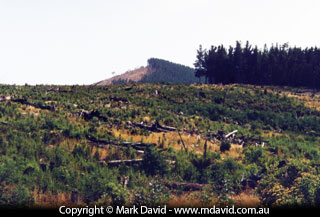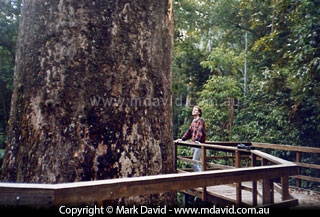
It’s possible that the tallest trees that ever lived grew in Australia. Unfortunately historical records aren’t very good and so the claim can’t be confirmed, although Australia does still have the tallest hardwood trees in the world.
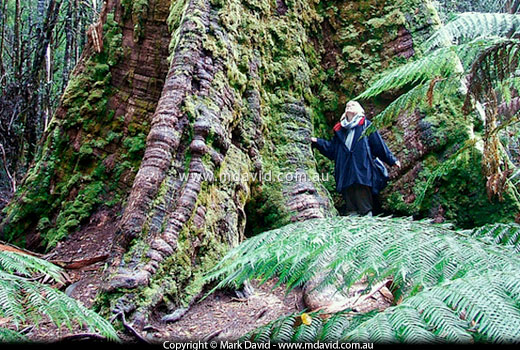
This lovely big old Eucalyptus regnans is still growing in Tasmania
The first time I visited Tasmania was in 1993. It was an amazing, beautiful place, with the most remarkable old-growth forests that seemed to be everywhere. Some of those forests had the most bewildering, fantastic giant trees on the planet. It was nature all over — trees, wildlife, scenery, more scenery, more wildlife — okay, you get the idea.
Ten years later I went back and was shocked at how much it had changed. You can still have a great time in Tassie, but if you want to see nature then you will not be rewarded with the sheer abundance of wild beauty that I saw in ’93. However, you can still find some some preserved patches of the old magic, including some surviving giant trees, if you know where to find it. At the end of this page I link to a website that tells you about some of the biggest ones. It has some good photos too.
A real giant
One tree I’d have loved to see alive was a very famous Eucalyptus regnans called El Grande but like with so many of the best trees I’ve left my run too late. It was a beautiful tall, healthy gum tree — the most massive tree in Tasmania — until it suddenly became the most massive Tasmanian dead tree in 2003. With a volume of 439 cubic metres it was one of the world’s most special and significant trees and made the one shown above look small. More information here and here.

A stand of Swamp Gums (Eucalyptus regnans) growing in Tasmania in 1993. This image shows how some of today’s giants might have looked when they were perhaps a hundred years younger.
According to the 1999 edition of the Guiness Book of Records the tallest tree ever measured was 132.6 metres (435 feet) and had once been more than 150 metres (500 feet). Perhaps it was one of the giant gum trees, the Eucalyptus regnans which hit that mark. Those trees, called Swamp Gums in Tasmania or Mountain Ash in mainland Australia, are famous for reaching incredible heights in high-rainfall areas with decent soils. You can still see some nice tall regnans in Victoria and Tasmania. Tasmania still has the biggest but Victoria has some really tall ones that just might be left alone long enough to take the record.
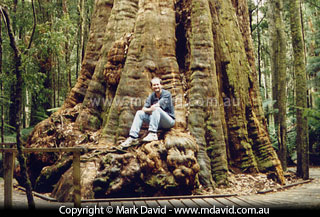
Most people would have no idea that gum trees can reach this size. This lovely old specimen was at Dip Falls, near Mawbanna in northern Tasmania. It looked like it was slowly dying — possibly of old age — when I saw it in 2000, but it still looked superb
Shrinking Nature
When my grandparents were kids, the tree in the photo above would have been the kind of thing they were talking about when they referred to a big gum tree. Now, most people wouldn’t even believe you if you said gum trees can get this big. They’d say a big gum tree would be no more than about 6 feet across its base. And if you look around these days, it’s getting harder to prove that wrong unless you’re prepared to do a bit of travelling to places like Victoria or Tasmania. This phenomena, where the big things just aren’t as big as they used to be, and where people don’t believe they ever were, is sometimes referred to as ‘Shrinking Nature’.
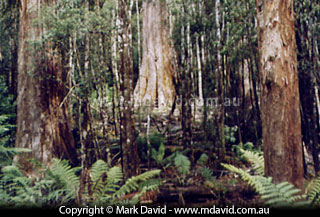
A younger generation of Swamp Gums grows among some giants along the Tall Trees Walk in Tasmania’s Mount Field National Park
Mount Field National Park, Tasmania
Some of the trees here are amazing. Real teary-eyed stuff, in my opinion. It takes about half an hour to cover the length of the Tall Trees Walk. That tree in the big picture at the top of this page is one of the giants growing along that trail. If I’m walking the Tall Trees walk I personally find it even better to take in Russell Falls along the way. The Tall Trees walk takes you past plenty of lovely tall gum tree giants (Eucalyptus regnans). In fact, after seeing so many tall trees you start taking them for granted (until you get back home and realise you can’t shake the memory of those trees out of your head). Another good trail at Mount Field National Park is the Lyrebird Trail. Not as many tall trees as the Tall Trees Walk, but in its own way perhaps even more beautiful.
Last time I was on the Tall Trees Walk it was close to sunset and I saw almost 20 wallabies within half an hour. It was great to see that much wildlife and it reminded me of the idyllic place Tasmania was before the poison baits.
Arve Big Tree
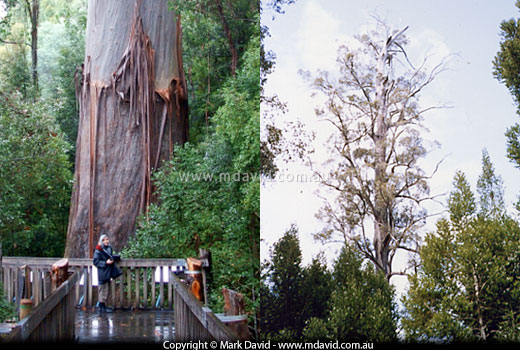
First time I saw this giant was in 1993. As is so often the case, the photos here don’t do justice to the size of it. It had an impressive 17.2 metre (56.4 feet) girth and was 86 metres (282 feet) high.
You can see from the photo above right that the top of it had been exploded off in a lightning strike. The tallest trees in a forest are most at risk of being hit in a storm and I got used to seeing this kind of damage.
When lightning strikes a tree it super-heats the moisture in the timber, causing it to instantly turn into steam and expand, and that makes the timber explode. Thankfully, trees like this one can often survive if most of the trunk is undamaged, even if they do come out of the experience lacking some of their earlier height.
Big Eucalyptus regnans, Tasmania
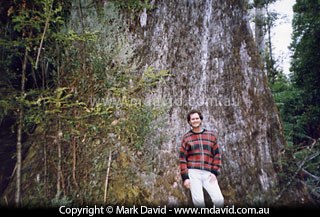
It might not have the widest base but this tree, a Eucaluptus regnans, was once listed in the Guiness Books of Records as the tallest hardwood in the world. In 1962 it was 99 metres tall (325 feet) and it kept growing until a lightning strike blew the top third off it. This tree stood alongside many other giants in the Styx Valley in Tasmania.

